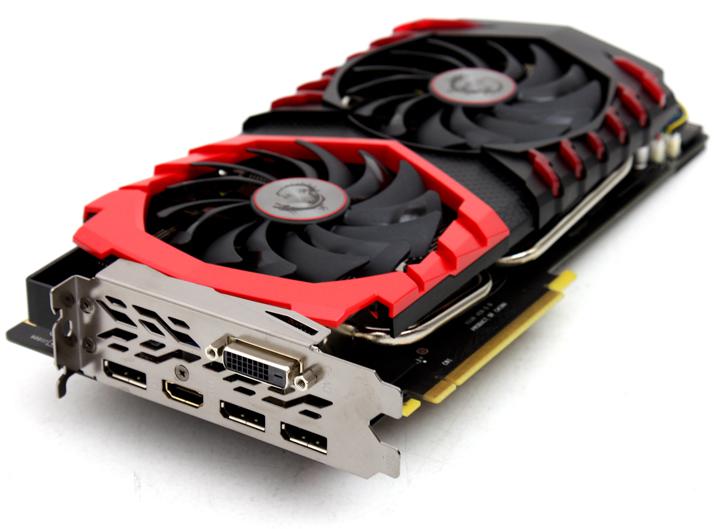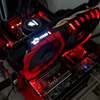Introduction
MSI GeForce GTX 1070 GAMING X 8G
Better price / heaps of powah !
We review the MSI GeForce GTX 1070 Gaming X armed with 8GB GDDR5 graphics memory. Now we all like the reference founders edition cards, but be honest with me .. everybody really waiting to see the board partner cards, right ? These are factory tweaked and cooled better. Let's check out the new 8 GB beast from MSI, the GTX 1070 GAMING X 8G with the very cool TwinFrozr revision VI cooler. When the initial Pascal articles launched three weeks ago, it caught us a bit by surprise, the actual reference review took down this site for a couple of minutes as our load-balanced front-end servers could not handle the near 2500% increase in traffic. Crazy stuff, and that is testimony to the fact that you guys have been waiting very long on the new graphics cards from both AMD and Nvidia. It's for good reason, the graphics card industry, or the GPU industry has been on hold, waiting for a smaller GPU fabrication process to become viable. Last generation GPUs were based on a 28 nm fabrication, an intermediate move to 20 nm was supposed to be the answer for today’s GPUs, but it was a problematic technology. Aside from some smaller ASICs the 20 nm node has been a fail. Therefore the industry had to wait until an ever newer and smaller fabrication process was available in order to shrink the die which allows for less voltage usage in the chips, less transistor gate leakage and, obviously, more transistors in a GPU. The answer was to be found in the recent 14/15/16 nm fabrication processors and processes with the now all too familiar FinFET + VLSI technology (basically wings on a transistor). Intel has been using it for a while, and now both Nvidia and AMD are moving towards such nodes as well. Nvidia is the first to announce their new products based on a TSMC 16 nm process fab by introducing Pascal GPU architecture, named after the mathematician much like Kepler, Maxwell and Fermi. That stage has now passed, the GeForce GTX 1070 and 1080 have been announced with the 1080 slowly becoming available in stores as we speak, the 1070 cards you'll start to see selling by next week (June 10th 2016). Both cards are equally impressive in it's product positioning, though I do feel the 1070 will be the more attractive product due to it's price level, the 1080 cards really is what everybody want (but perhaps can't afford). The good news though is that the board partner cards will sell for less opposed to the Nvidia reference / Founder edition cars. Obviously the higher-end all customized SKUs will likely level with that founders edition card price level again, but I am pretty certain you'd rather spend your money on a fully customized AIB card that is already factory tweaked a bit opposed the the reference one.
In this review we look at the MSI GeForce GTX 1070 GAMING X 8G fitted with a Pascal GP104 based GPU. A product series that is to replace the GeForce GTX 980. It's all custom with 10 power phases, has a nice dark aesthetic feel and comes with the all new TwinFrozr VI model cooler, that is marketed as a cooler with Balls of Steel. Seriously I am not making that up, it literally was in the press release and actually refers towards the Double Ball Bearings that the fans use -- made out of steel. The GeForce GTX 1070 is all about that Pascal GP104 GPU, yet for obvious reasons had to be slowed down a bit. The GeForce GTX 1070 might have the same GP104 GPU housed on it's PCB as the 1080, however it is a cut-down version of the GPU as Nvidia stripped away some segments. Where the GeForce GTX 1080 has 2560 shader processors, the GeForce GTX 1070 has 1920 shader processors. This means it is has 15 out of the 20 SMs active (15 streaming multi-processors x 128 shader cores). In order of magnitude, the secondary biggest change is the memory type being "regular GDDR5" memory and not the new and hip GDDR5X. That memory is clocked at 2,000 MHz which is 8 GHz (GDDR5-effective) at a memory bandwidth of 256 GB/s. The two differences are responsible for a performance drop from 9 TFLOP/s Single-precision floating point performance for the GeForce GTX 1080 towards 6.45 TFLOP/s for the GeForce GTX 1070. You will have noticed that MSI is to release a regular Gaming and then an X and a Gaming Z model. The regular Gaming model (no X or Z) will not have the backplate and configurable RGB LED light system and basic clock frequencies. Then there are the X models, these are released in the initial launch and come with a backplate and RGB system and are clocked a notch higher. Then the Z models will be the most high-end SKU, even more overclocked with all the benefits the X model has as well. So we test the X model, but there will be even faster clocked revisions. The Gaming Z gives you all the features of the Gaming X, but with higher clock speeds. Right with that explained, the cooling perf has been improved and combined with a new generation fans, the airflow is improved whilst remaining silent. Up-to 60 Degrees C the card will even stay in passive mode, e.g. the fans will not spin. The TWIN FROZR cooler is now intensified by a red GAMING glow piercing through the cover, while the MSI GAMING dragon RGB LED on the side can be set to any of 16.8 million colors to match the LED lights in the color-tone of your PC. The GTX 1070 GAMING X 8G comes with MSI's traditional Military Class 4 components and holds both an 8- and 6-pin power connector. At the backside you'll spot a nice matte black solid backplate. Both versions do have TwinFrozer VI as wel as a memory cooling plate and a PWM heatsink.
The MSI GeForce GTX 1070 GAMING X 8G is capable of clock frequencies of 1797 MHz (boost) / 1607 base) MHz (in OC mode) with 8192 MB GDDR5 / 8100 MHz effective data-rate on the memory. Straight out of the box your card will be clocked at 1582/1771 MHz. Right, we have enough to talk about and to show, let's head on-wards in the review. We'll start with a product overview in the photo-shoot.

MSI GeForce GTX 1070 Gaming X 8G with the Nvidia GP104-200 GPU ( 1607 MHz core / 1797 MHz boost / 8108 MHz memory )

